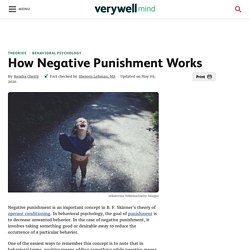

The concept of operant conditioning consists of two different conditioning: Operant Conditioning: Reinforcement & Punishment. Changing Behaviour through Reinforcement and Punishment: Operant Conditioning. Learning Objectives Outline the principles of operant conditioning.Explain how learning can be shaped through the use of reinforcement schedules and secondary reinforcers.

In classical conditioning the organism learns to associate new stimuli with natural biological responses such as salivation or fear. The organism does not learn something new but rather begins to perform an existing behaviour in the presence of a new signal. Operant conditioning, on the other hand, is learning that occurs based on the consequences of behaviour and can involve the learning of new actions. An Overview on How Positive and Negative Reinforcement and Punishment Influence Behaviour. What is Reinforcement ? One of the many different ways in which people can learn is through a process known as operant conditioning (also known as instrumental conditioning).1 This involves learning through reinforcement or punishment.

The type of reinforcement used can play an important role in how quickly a behavior is learned and the overall strength of the resulting response. Understanding Reinforcement Reinforcement is a term used in operant conditioning to refer to anything that increases the likelihood that a response will occur. Psychologist B.F. Skinner is considered the father of this theory. Reinforcement Schedules. What is Positive Reinforcement? In operant conditioning, positive reinforcement involves the addition of a reinforcing stimulus following a behavior that makes it more likely that the behavior will occur again in the future.

When a favorable outcome, event, or reward occurs after an action, that particular response or behavior will be strengthened. One of the easiest ways to remember positive reinforcement is to think of it as something being added. By thinking of it in these terms, you may find it easier to identify real-world examples of positive reinforcement. Positive Reinforcement. What is Negative Reinforcement? Negative reinforcement is a term described by B.

F. Skinner in his theory of operant conditioning. In negative reinforcement, a response or behavior is strengthened by stopping, removing, or avoiding a negative outcome or aversive stimulus.1. Negative Reinforcement Negative Reinforcers involve the removal of unfavourable events or outcomes after the display of a behaviour. In these situations, a response is strengthened by the removal of something considered unpleasant.
What is Positive Punishment ? Positive punishment is a concept used in B.F.

Skinner's theory of operant conditioning. How exactly does the positive punishment process work? The goal of any type of punishment is to decrease the behavior that it follows. Positive punishment sometimes referred to as punishment by application, presents an unfavourable event or outcome in order to weaken the response it follows. Negative Punishment. How Negative Punishment Works. Negative punishment is an important concept in B.

F. Skinner's theory of operant conditioning. In behavioral psychology, the goal of punishment is to decrease unwanted behavior. In the case of negative punishment, it involves taking something good or desirable away to reduce the occurrence of a particular behavior.